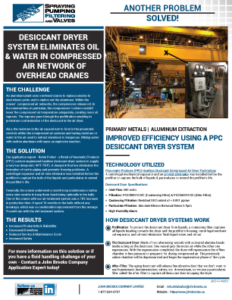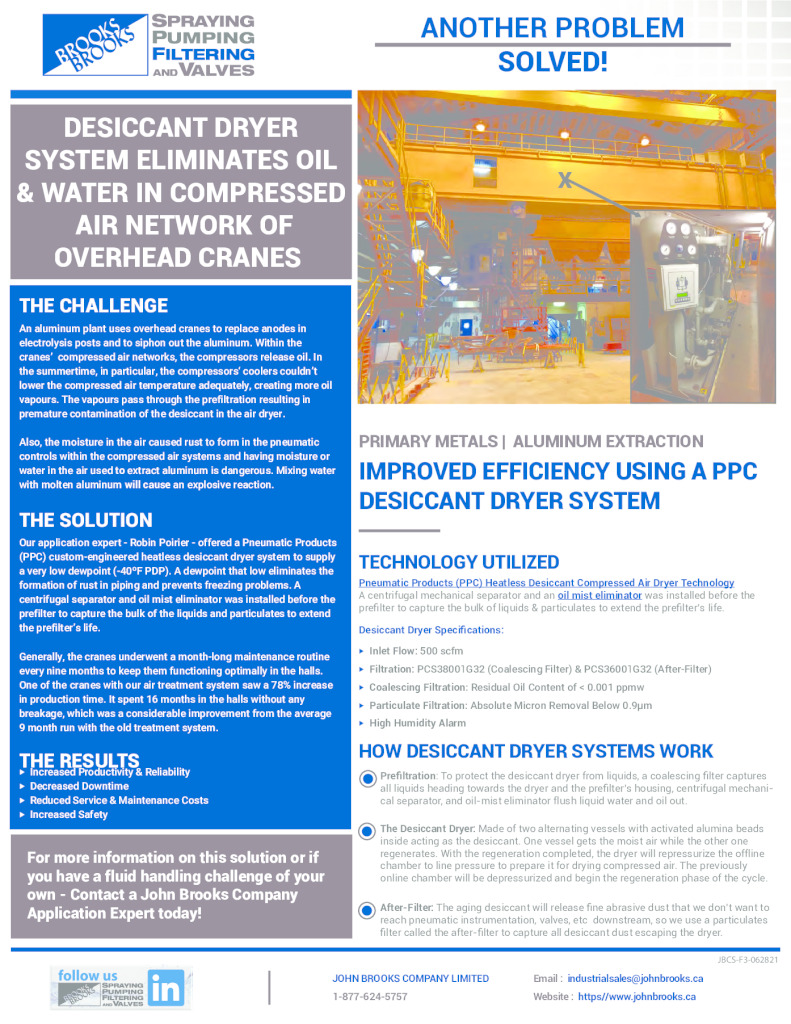How a Custom Engineered Air Treatment System with a -40º Compressed Air Dewpoint Solved a Challenging and Dangerous Application
The Challenge: Oil and Water in Compressed Air Systems of an Aluminum Extractor
The customer runs an aluminum plant, and during production, they have to use overhead cranes to replace anodes in electrolysis pots and siphon out the aluminum. Within the cranes’ compressed air networks, the compressors release oil. In the summertime, in particular, the compressors’ coolers couldn’t lower the compressed air temperature adequately, creating more oil vapours. The vapours pass through the prefiltration resulting in premature contamination of the desiccant in the air dryer.
The other problem was the moisture in the air caused rust to form in the pneumatic controls within compressed air systems. That same air is used for aluminum extraction (i.e., by creating a Venturi vacuum). Having moisture or water in the air used to extract aluminum is dangerous because mixing water with molten aluminum will cause an explosive reaction.
The Solution: Custom Engineered Heatless Desiccant Dryer System
Our application expert—Robin Poirier—offered a Pneumatic Products (PPC) custom-engineered heatless desiccant dryer system to supply a very low dewpoint (-40°F PDP). A dewpoint that low eliminates the formation of rust in piping and prevents freezing problems.
In this specific application, we installed a centrifugal mechanical separator and an oil mist eliminator before the prefilter to capture the bulk of liquids and particulates to extend the prefilter’s life.
The advantages were:
- The filters get more filtration surface area
- They can filter more particulates for longer, decreasing maintenance and downtime
- The low dewpoint eliminates rust and moisture that might cause explosions downstream
The Result: 78% Increase in Production Time & Reduced Breakage and Maintenance
Adding the air treatment system reduced the maintenance time and chances of equipment failure. They’re saving costs on maintenance and not losing valuable production on costly downtime.
Our solution was a success for the customer since the overhead cranes remained in the halls completing their tasks much longer than they were previously. When they’re in the garage, they’re not extracting aluminum, which means less production and revenue.
Generally, the cranes underwent a month-long maintenance routine every nine months to keep them functioning optimally in the halls. They push their cranes hard to ensure their production rates stay up. One of the cranes with our air treatment system saw a 78% increase in production time. It spent 16 months in the halls without any breakage, which was a considerable improvement from the average 9 month run with the old treatment system.
The results were:
- Less breakage and downtime
- Increased productivity and reliability
Pneumatic Products (PPC) Heatless Desiccant Compressed Air Dryer Technology Used
We solved the customer’s problems using a custom-engineered heatless desiccant air dryer system.
Desiccant Dryer Specs
- Inlet flow: 500 scfm
- Filtration: PCS38001G32 (Coalescing Filter) & PCS36001G32 (After-Filter)
- Coalescing filtration: Residual Oil Content of < 0.001 ppmw
- Particulate filtration: Absolute Micron Removal Below 0.9µm
- Flanged manifold construction to allow access to internal diffusers
- Stainless steel control valves explicitly designed for desiccant dryer service and tested to 1,000,000 cycles, bubble-tight
- Modular Electronic Controller (MEC) with AMLOC® energy management
- Heavy-duty low-noise exhaust muffler
- High humidity alarm
- Premium Grade DE-4 Activated Alumina beads
How a Desiccant Dryer Works
A desiccant dryer base set up includes three things:
- Prefiltration: a coalescing filter captures all liquids heading towards the dryer. The prefilter’s housing as well as the centrifugal mechanical separator & oil-mist eliminator have an automatic drain valve to flush liquid water and oil out. Its task is to protect the desiccant dryer from liquids.
- The desiccant dryer is made of two alternating vessels with activated alumina beads inside acting as the desiccant. One vessel gets the moist air while the other one regenerates. At atmospheric pressure, the regeneration uses a percentage of dry air from the online drying vessel and passes the required scfm at atmospheric pressure into the depressurized vessel. With the regeneration completed, the dryer will re-pressurize the offline chamber to line pressure to prepare it for drying compressed air. The previously online chamber will be depressurized and begin the regeneration phase of the cycle.
- After filter: The aging desiccant will release fine abrasive dust that we don’t want to reach pneumatic instrumentation, valves, and so on downstream, so we use a particulates filter called the after-filter. The after-filter captures all desiccant dust escaping the dryer.





